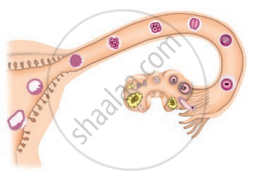Advertisements
Advertisements
प्रश्न
Hens and frogs are both oviparous exhibiting different types of fertilisation. Explain.
उत्तर
Hens are oviparous in which internal fertilisation takes place. The fertilised egg divides repeatedly to form an embryo inside the body. The embryo however, travels down the oviduct with many protective layers forming around it. After the hard egg shell is formed around the developing embryo, the hen lays the eggs outside. After about 3 weeks, the development of chick from egg takes place.
On the contrary, frogs are oviparous in which external fertilisation occurs. The frogs lay eggs and sperms in water, which comes in contact to undergo fertilisation. In this way, a female frog’s eggs get fertilised by sperms outside its body, i.e external fertilisation.
The fertilised eggs are covered by a jelly for protection. The development of embryo takes place in the egg in water, i.e they are oviparous.
APPEARS IN
संबंधित प्रश्न
______ is an oviparous animal.
Match the following.
| 1. | Zycote | Asexual Reproduction |
| 2. | Viviparous | Elephant |
| 3. | Endangered animal | Cat |
| 4. | Mudhumalai | Fertilised Egg |
| 5. | Fragmentation | Rhinoceros |
Differentiate between oviparous and viviparous animals.
Stages in the life cycle of silkworm are given below. Write them in sequential order.
| Pupa | Egg | Silk moth | Caterpillar |

After Observing above figure, answer the following,
- Read the following statements and label them in the figure.
(i) The part which produces female gametes.
(ii) The part where development of the baby takes place.
(iii) The part through which the developing embryo passes to reach the uterus. - Explain the future development of the embryo that would take place after it gets embedded in the uterus.
